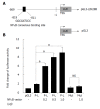NF-κB promotes the stem-like properties of leukemia cells by activation of LIN28B
- PMID: 29707103
- PMCID: PMC5919888
- DOI: 10.4252/wjsc.v10.i4.34
NF-κB promotes the stem-like properties of leukemia cells by activation of LIN28B
Abstract
Aim: To examine whether nuclear factor kappa B (NF-κB) activity regulates LIN28B expression and their roles in leukemia stem cell (LSC)-like properties.
Methods: We used pharmacological inhibitor and cell viability assays to examine the relation between NF-κB and LIN28B. Western blot and qRT-PCR was employed to determine their protein and mRNA levels. Luciferase reporter was constructed and applied to explore the transcriptional regulation of LIN28B. We manipulated LIN28B level in acute myeloid leukemia (AML) cells and investigated LSC-like properties with colony forming and serial replating assays.
Results: This study revealed the relationship between NF-κB and LIN28B in AML cells through drug inhibition and overexpression experiments. Notably, inhibition of NF-κB by pharmacological inhibitors reduced LIN28B expression and decreased cell proliferation. We demonstrated that NF-κB binds to the -819 to -811 region of LIN28B promoter, and transcriptionally regulates LIN28B expression. LIN28B protein was significantly elevated in NFκB1 transfected cells compared to vector control. Importantly, ectopic expression of LIN28B partially rescued the self-renewal capacity impaired by pharmacological inhibition of NF-κB activity.
Conclusion: These results uncover a regulatory signaling, NF-κB/LIN28B, which plays a pivotal role in leukemia stem cell-like properties and it could serve as a promising intervening target for effective treatment of AML disease.
Keywords: Acute myeloid leukemia; LIN28B; Leukemia stem cell; Nuclear factor kappa B.
Conflict of interest statement
Conflict-of-interest statement: No potential conflicts of interest relevant to this article were reported.
Figures




Similar articles
-
Inhibition of LIN28B impairs leukemia cell growth and metabolism in acute myeloid leukemia.J Hematol Oncol. 2017 Jul 11;10(1):138. doi: 10.1186/s13045-017-0507-y. J Hematol Oncol. 2017. PMID: 28693523 Free PMC article.
-
CaMKIIγ regulates the viability and self-renewal of acute myeloid leukaemia stem-like cells by the Alox5/NF-κB pathway.Int J Lab Hematol. 2021 Aug;43(4):699-706. doi: 10.1111/ijlh.13440. Epub 2020 Dec 25. Int J Lab Hematol. 2021. PMID: 33369192
-
MicroRNA-125a regulates proliferation and apoptosis of acute myeloid leukemia through targeting NF-κB pathway.Eur Rev Med Pharmacol Sci. 2019 May;23(9):3594-3601. doi: 10.26355/eurrev_201905_17781. Eur Rev Med Pharmacol Sci. 2019. PMID: 31114983
-
Nuclear factor-kappaB signaling: a contributor in leukemogenesis and a target for pharmacological intervention in human acute myelogenous leukemia.Crit Rev Oncog. 2009;15(1-2):1-41. doi: 10.1615/critrevoncog.v15.i1-2.10. Crit Rev Oncog. 2009. PMID: 20136626 Review.
-
[NF-κB activity in myeloid leukemia stem cells].Rinsho Ketsueki. 2015 Apr;56(4):384-91. doi: 10.11406/rinketsu.56.384. Rinsho Ketsueki. 2015. PMID: 25971268 Review. Japanese.
Cited by
-
Anti-Inflammatory and Cancer-Preventive Potential of Chamomile (Matricaria chamomilla L.): A Comprehensive In Silico and In Vitro Study.Biomedicines. 2024 Jul 5;12(7):1484. doi: 10.3390/biomedicines12071484. Biomedicines. 2024. PMID: 39062057 Free PMC article.
-
Correlation between expression of Lin28B and C-myc in patients with laryngeal squamous cell carcinoma and clinicopathological features and prognosis.Zhong Nan Da Xue Xue Bao Yi Xue Ban. 2023 Feb 28;48(2):165-171. doi: 10.11817/j.issn.1672-7347.2023.220421. Zhong Nan Da Xue Xue Bao Yi Xue Ban. 2023. PMID: 36999462 Free PMC article. Chinese, English.
-
GNL3L exhibits pro-tumor activities via NF-κB pathway as a poor prognostic factor in acute myeloid leukemia.J Cancer. 2024 May 30;15(13):4072-4080. doi: 10.7150/jca.95339. eCollection 2024. J Cancer. 2024. PMID: 38947394 Free PMC article.
-
Interplay between proteasome inhibitors and NF-κB pathway in leukemia and lymphoma: a comprehensive review on challenges ahead of proteasome inhibitors.Cell Commun Signal. 2024 Feb 8;22(1):105. doi: 10.1186/s12964-023-01433-5. Cell Commun Signal. 2024. PMID: 38331801 Free PMC article. Review.
-
NF-κB: A Druggable Target in Acute Myeloid Leukemia.Cancers (Basel). 2022 Jul 21;14(14):3557. doi: 10.3390/cancers14143557. Cancers (Basel). 2022. PMID: 35884618 Free PMC article. Review.
References
-
- Ghosh A, Saginc G, Leow SC, Khattar E, Shin EM, Yan TD, Wong M, Zhang Z, Li G, Sung WK, et al. Telomerase directly regulates NF-κB-dependent transcription. Nat Cell Biol. 2012;14:1270–1281. - PubMed
-
- Cildir G, Low KC, Tergaonkar V. Noncanonical NF-κB Signaling in Health and Disease. Trends Mol Med. 2016;22:414–429. - PubMed
LinkOut - more resources
Full Text Sources
Other Literature Sources

